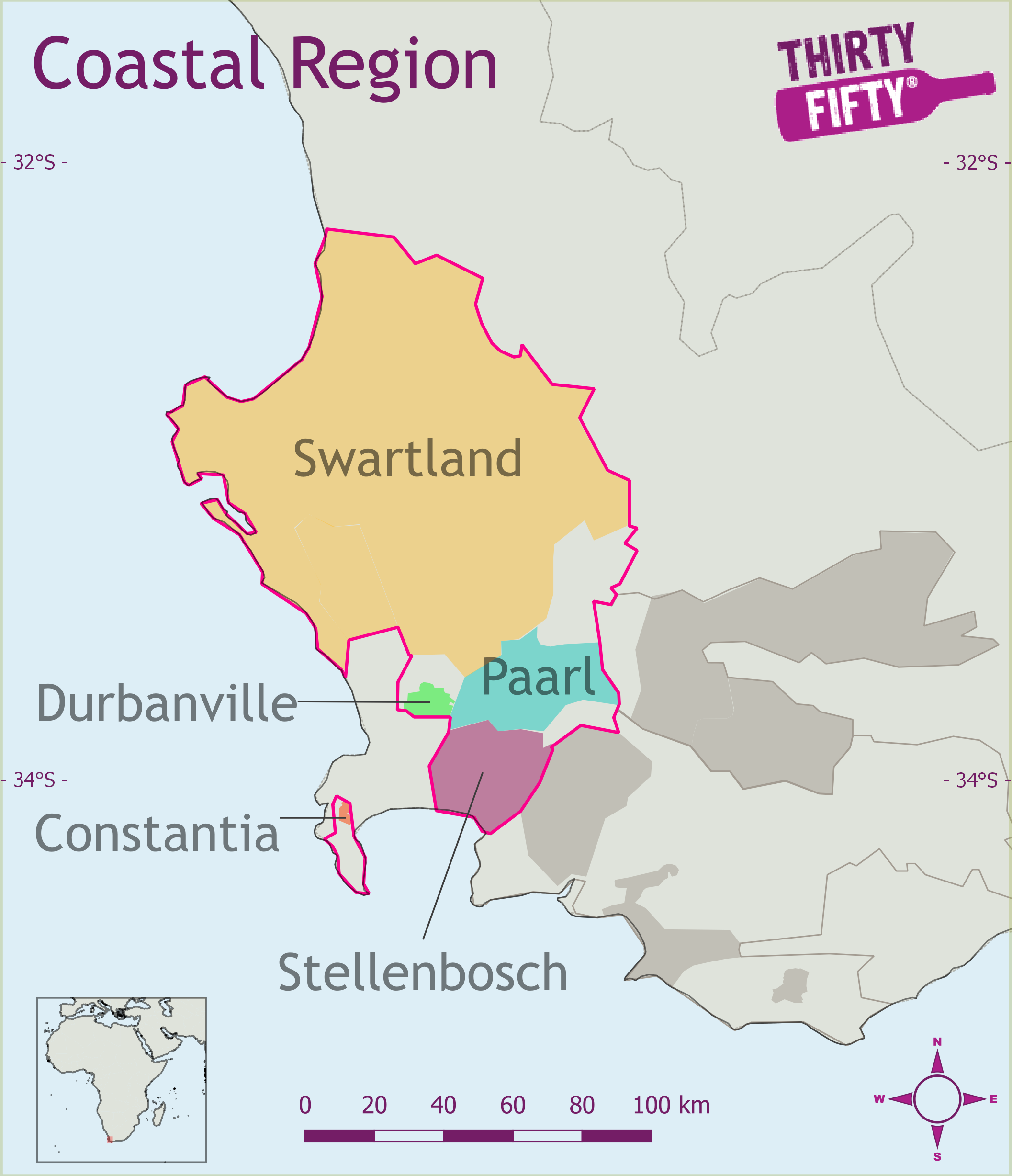Coastal Region (SA)'s Grapes: Cabernet Sauvignon, Chardonnay, Chenin Blanc, Merlot, Sauvignon Blanc, Syrah, Pinotage
Cabernet Sauvignon
Cabernet Sauvignon is perhaps the most famous red grape. Its home is Bordeaux where it is was created as a cross between Cabernet Franc (red grape) and Sauvignon Blanc (white grape). Since then its popularity has spread and it is grown all around the world. It prefers warmer climates to ripen fully and even in Bordeaux some years it does not ripen. That is why Cabernet Franc is also used in Bordeaux blends as it ripens faster. What makes Cabernet so popular is not its bouquet, which can range from blackcurrants to cigar box, but its structure, typically having both tannins and acidity to create a smooth feeling in the mouth. The structure allows the blending with other grapes, perhaps the most famous pairing is Cabernet Sauvignon and Merlot where the Cabernet provides the structure and the Merlot gives the wine the soft, rounded feel in the mouth. Recently Cabernet has been mixed with Sangiovese (Chianti's grape) to create the SuperTuscans.
Chardonnay
Jancis Robinson described Chardonnay as the tart of the grape world, as it would lie down anywhere and do what the winemaker told it to do! In other words it will grow almost anywhere and produce decent and quite stylistically different wines ranging from minerally Chablis, Champagne, buttery fruit wines, tropical fruit wines or oaky vanilla wines. During the late 1990's Chardonnay was the drink of choice for many. However people became bored with the oaky wines found in so many bars and the term, 'ABC' (Anything but Chardonnay) came about. The ubiquitous yet noble Chardonnay grape has virtually become a brand name. From its homeland in Burgundy, its fame and fortune have taken it all over the world. It�s grown on different soils in varying climates to be used either as a single varietal or in blends, for still and sparkling wines, and with or without oak ageing to create a wide range of wines with diverse personalities. As a result, it�s impossible to describe a typical Chardonnay. For a start, the grape can make anything from an everyday glugger to a high-quality wine deserved of ageing. Its popularity in the vineyard stems from the fact that it�s easy to grow, consistently yielding generously with relatively high sugars (and, therefore, alcohol). In the winery its advantages are obvious � it�s difficult to make a poor wine from it, unless it�s been picked too late, because then its acid levels fall quickly, which make it flabby. Chardonnay isn�t strongly aromatic: some detect anything from apples (or barely ripe apples in Chablis) and melon in Maconnais Chardonnay to tropical fruit flavours in New World examples. Common descriptives, however, tend to refer to texture and weight rather than flavour � buttery for broader styles, such as Meursault from the Cote de Beaune; steely for Montrachets and nutty for Corton-Charlemagne. There�s an attractive leanness to fine Cote d�Or white burgundy, that sets it apart from Chardonnays from the rest of the world, but this can be emulated further south in the Cote Chalonnaise and Maconnais in good vintages with clever winemaking.
Chenin Blanc
Chenin Blanc is a native of France, or more specifically the Loire, yet it's now more prevalent in South Africa, where it is the most planted grape. This white grape is certainly versatile: it goes from producing some of the finest, most age worthy sweet wines to being responsible for a vast amount of sparkling wine, basic New World gluggers and high-quality examples. In South Africa, it is also used as a base for fortified wines and spirits. The variety is marked by the flavours of honey, flowers and damp straw as well as high acidity, which can be a problem in the Loire's less-ripe vintages but is a bonus in hotter climates. It's a vigorous grower with good resistance to disease and wind, but it buds early, which exposes it to spring frosts, and ripens late. In newer wine regions, it's grown on a wide variety of soils but French growers prize the calcareous soils, particularly the tuffeau of Touraine. In fact, it's Touraine as well as Anjou-Saumur that are Chenin's bases today in the Loire. Here, wines range from basic and vaguely floral to intense honeyed wines made either sweet (moelleux), dry or demi-sec, but all with vibrant acidity. The region's Chenin sparklers include Saumur Mousseux, Cremant de Loire and Vouvray, while, in the south, the grape is also an ingredient with Mauzac and Chardonnay in the sparkling wines of Limoux. Chenin Blanc is also grown in other New World countries, including Australia and America (mostly California), where it's often blended. In France, it is sometimes called Pineau or Pineau de la Loire and in South Africa it also goes by the name Steen.
Merlot
Merlot makes luscious, smooth and fruity wines. In spite of this, it�s still perceived as one of the vine world�s great underdogs, most often being unfavourably compared to prized Cabernet Sauvignon, its more austere and frequent blending partner. Planted throughout South West France and much of the rest of the world, Merlot means �little blackbird� in Bordeaux patois, and was so-called because it was said that it�s the grape the blackbird guzzles first and that the bird�s colour resembles the grapes. It produces its most glorious wines in St-Emilion and Pomerol, on the right bank of the Gironde, including Bordeaux�s most expensive wine, Chateau Petrus. Chile's soft plum aromas are a favourite to many consumers. Merlot can adapt to a wide range of soils and microclimates, but it buds, flowers and ripens relatively early, so spring frosts are a danger. Its thin-skinned grapes are also liable to rot in wet vintages. However, Merlot�s lowish fruit tannins make it an excellent early-drinking wine.
Sauvignon Blanc
Grassy and herbaceous, with the characteristics of gooseberries, nettles and cat�s pee � this can only be referring to one grape variety: Sauvignon Blanc. The grape has its origins in Bordeaux but is now widely cultivated over France and around much of the world. Think of Pouilly-Fume and Sancerre from the Loire � both these wines are made from Sauvignon Blanc and are, probably, the grape in its purest form: crisp, dry, aromatic and unoaked. In Bordeaux, it�s blended, particularly with Semillon, for the dry whites there, but it�s also an ingredient for the region�s luscious dessert wines, such as those of Sauternes and Barsac. On the other side of the world, however, New Zealand has also virtually made this white variety its own, giving the wine a screwcap along the way. Yet this fashionable grape does have its faults. For one, unblended, it doesn�t age. Wines made from Sauvignon Blanc are generally meant to be drunk young, but then that can also be a bonus � as soon as you�ve bought a bottle, you can just chill this zesty little number and enjoy it! On the growing front, it�s susceptible to botrytis, oidium and black rot and will also rot if grown on fertile soils, preferring gravelly or sandy loams, or chalk in parts of the Loire. It also tends to be very vigorous and if it�s allowed to become over-productive on heavy soils, then the characteristics of the wines will be much diluted. Sauvignon Blanc goes by a few other names, the most common probably being Fume Blanc, as it�s known in California.
Syrah
Shiraz and Syrah are the same grape. However apart from Australia where it is always called Shiraz, and France where it is Syrah, the rest of the world tends to follow the style of these two. If the wine is ripe and full bodied the wine is often called Shiraz. If the wine has less fruit, more acidity and lower alcohol, it tends to be called Syrah after the wines produced into the North of Rhone. Shiraz/Syrah is produced by itself or can be blended typically in three ways. A small amount of the white grape Viognier can lift the deep flavours of Syrah, this is common in Northern Rhone. In Southern Rhone and recently Australia, blending has been based around adding Grenache and Mourvedre, copying the blending behind Chateauneuf-du-Pape. Even more recently Cabernet Sauvignon and Shiraz/Syrah has been blended in the Southern French wine region of Languedoc, creating big wines with elegance. Hotter climate Shiraz often has aromas of plum, tar and leather and with the right oak treatment even chocolate. Cooler climate Syrah can have a peppery note to the wine.
Pinotage
Pinotage is SouthAfrica's very own creation, a red grape, created by Professor A L Perold of Stellenbosh University in 1925. It's a cross between Pinot Noir and Cinsault (know in South Africa as Hermitage, hence the name Pinotage) and although didn't show too much early potential has been improved over the years. The traditional style tended to develop sweet paint-like flavours and bitter nail varnish characters with tannins taking years to soften. In the mid 1990's winemakers experimented with prolonged cool fermentation and short hot fermentation to inhibit certain characteristics, such as burnt rubber aromas. That combined with the use of oak has since created modern, fruit-forward versions that are showing complexity. Pinotage has also been planted in California and New Zealand.
Wine Regions for Coastal Region (SA)
- Constantia
- Durbanville
- Paarl
- Stellenbosch
- Swartland
Coastal Region (SA)
Key Grape Varieties: Cabernet Sauvignon, Chardonnay, Chenin Blanc, Merlot, Sauvignon Blanc, Syrah, Pinotage

The Coastal Region is the most important wine-producing region in South Africa. Located in the Western Cape, it comprises of eight districts – Cape Point, Darling, Franschhoek, Paarl, Stellenbosch, Swartland, Tulbagh and Tygerberg – as well as the ward of Constantia.
The climate here is generally Mediterranean, with the heat of the sun tempered by the Benguela current from Antarctica. Also an influence is the ‘Cape Doctor’, the frequent gale-force, summer south-easter wind, which helps to reduce humidity, mildew and other fungal diseases, though it can batter the vines. Climates within the districts and the soils vary enormously – Stellenbosch, for instance, has more than 50 soil types. Soils tend to have a lot of clay and be well-drained yet moisture-retentive, while decomposing granite dominates the hillsides.
Constantia, with over 350 years of wine history dating from the first European settlers, makes use of its cooling sea breezes to produce poised ocean-cooled Sauvignon Blanc, Semillon and sweet Muscat wines, plus elegant Bordeaux-style blends. Stellenbosch, the oldest wine region after Constantia, produces a host of wine types and is best-known for ones from red Bordeaux grapes as well as Shiraz and Pinotage. However, it also makes some excellent Chardonnays and Sauvignon Blancs.
Franschhoek, the gourmet capital of the Cape, grows everything from Cabernet, Shiraz, Pinotage and Merlot to Sauvignon, Blanc, Chenin and Semillon, while Paarl, in the warmer heartlands, is the volume area of the Coastal Region. In fact, the ward of Wellington produces well over a quarter of South Africa’s total volume. However, the region is also recognised for rich, ripe Shiraz as well as other warmer-style wines from Cabernet, Merlot, Chenin Blanc and Chardonnay.
Swartland is the in new name – its potential just coming to the fore in spite of it having some of the oldest bush vine plantations in the country. Chenin Blanc and Rhone-varietal-driven blends are producing star wines here.
Darling excels with Sauvignon Blanc, as does maritime-chilled Cape Point - a small district concentrated on the sea-facing slopes of the Cape Peninsula, which also does well with Semillon and Chardonnay.
Tulbagh, a U-shaped valley shoe-horned into the foothills of the surrounding mountains, is making aromatic and intense yet well-structured Rhone-varietal-blended reds, achieved with help from the district’s elevation and high diurnal shifts in temperature.



